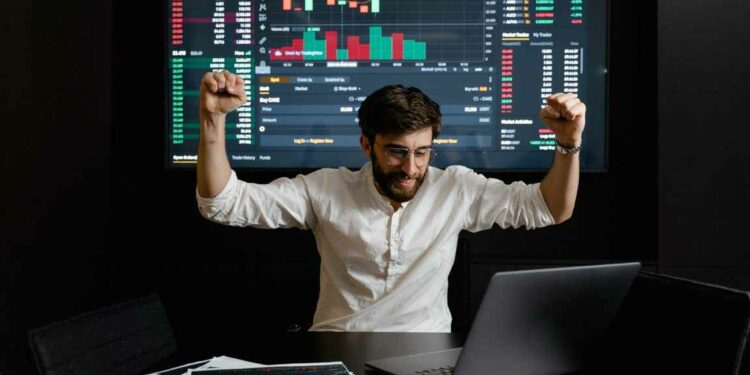Imagine if you could benefit from your trades without having to monitor the market all the time.
You would probably pay anything to have your transactions run automatically while still making a ton of money. So are you ready to take your investing game to the next level by utilizing algorithmic trading?
Algorithmic trading is a way for investors to use computational tools and analytical methods to identify patterns in historical prices, market trends, and other data points to inform their automated buying and selling decisions.
Using algorithms makes trading forex easier by removing human emotion from the equation. It lets you control your investments while staying up-to-date with current market conditions.
This article explores what algorithmic trading is all about and provides tips on getting started as a beginner!
Table of Contents
What is algorithmic trading?
Algorithmic trading involves using computer algorithms to trade the forex market or other suitable commodities. Using computer codes and software, it occurs when you initiate and close transactions based on predetermined criteria, such as price change in an underlying market.
Algorithmic trading lets you automate the buying or selling process based on pre-set conditions, saving time by eliminating the manual effort required to monitor market conditions. Summarily, trading decisions using algorithmic trading techniques are based on pre-set rules programmed into a computer.
When specific criteria are met, a trader or investor writes code that conducts deals on their behalf.
How algorithmic trading works
As stated earlier, algorithmic trading, or “algo trading,” is a sophisticated method that relies on complex formulas and coding based on a mathematical model. Contrary to traditional trading strategies, this procedure is entirely automated.
Humans create codes that tell computers to make judgments based on the circumstances. The automation of market analysis is made possible by using mathematical models and algorithms.
For instance, traders can start, close, enter, and exit deals based on the insights produced by these computerized systems. Investors frequently use algo trading in scalping, which is the rapid purchase and sale of assets to generate quick profits from small price fluctuations.
As a result, traders can engage in numerous daily transactions and profit from swift transaction completion.
Why use algorithmic trading?
- Eliminate human mistakes
Not even the most seasoned of traders is without emotion. Therefore, even if you think your methods are well-locked, there will be instances when you’ll make the wrong call. This is one of the very many essences of using algorithmic trading: trading without allowing feelings to prevent you from generating gains or eliminating losses
- Capitalize on uncommon or unique occurrences
Take action in response to sporadic occurrences; for instance, the Dow closing 500 points under its 20-day moving average.
- Boost your current strategy
Your current trading technique gets a buffer when you use algorithmic trading. It enables you to fine-tune risk management by utilizing algorithms to impose stops and limits.
- Simple to maintain
The upkeep of algorithmic trading is simple. Algorithms can be set up and allowed to trade according to your timetable.
- Backtest
Utilize previous data to improve your algorithms and find the ideal purchase or sell parameters.
- Greater chance of immediate execution
Utilize automated buy and sell orders to increase your exposure to the market.
- The last reason to utilize algorithmic trading is that algorithms can be set up to instantly examine huge amounts of market data, giving traders a deeper grasp of market trends and conditions.
How to get started with algorithmic trading

Algorithmic trading isn’t just a concept you see out there and jump at. It has resulted from serious work from developers to make trading easy, so you should take it seriously. Moreover, we’re talking about your hard-earned money here! What do you need to get started with algorithmic trading?
Study and understand the market
Any trading starts with understanding the market. Get a thorough understanding of the instrument or market you can trade in before you start trading with algorithms so that you can develop a hypothesis on which to base your trades.
Learn how to code
If you don’t know how to code, you can learn some coding languages such as Python, and develop your algorithm, or hire professionals to do it for you.
Backtest your strategy
It is imperative to thoroughly evaluate your algorithmic trading strategy before its implementation. This can be achieved by running simulations using high-quality historical data from credible sources.
To assess the effectiveness of your algorithmic trading strategies’ effectiveness, you can use third-party backtesting tools. By doing so, you can modify your code based on the results of these tests to ensure optimal performance.
Pick the right platform
Choosing the appropriate broker and trading platform is equally as important as the importance of your code. Choose a broker that offers a variety of tools that you can use to optimize your trading strategy and that supports your algorithm.
Launch
The next stage is to put your algorithm into real use. Keep an eye on how it operates in the market and in the actual world. Your algorithm may only sometimes perform as you expect. You then might have to start over or make adjustments following your needs.
Persevere
If your initial algorithmic trading approach proves unsuccessful, there’s no need to abandon the use of algorithmic trading altogether. Instead, try experimenting with different codes to determine which produces the most desirable results.
There is a ton of algo software available on the market that you can buy if you need more time or expertise to create your algorithm. Do your homework, backtest various strategies, and select the one that best satisfies your needs.



















